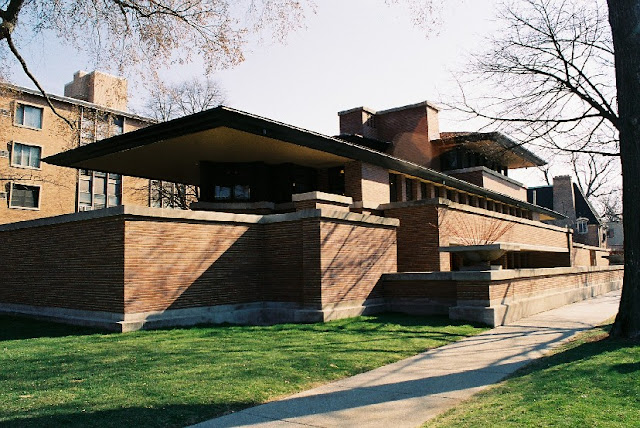Living in California has convinced me that the most interesting parts of a modern house are the roof and the patio. Get the roof right and the design of the home under it just follows naturally...or at least it seems that way when the architect is Cliff May.
May was known as the inventor of the modern ranch house. It's a style that combines cowboy ranch hand and Wright-style modernism with traditional Japanese, Mexican and Mediterranean styles. May was largely self-taught so he disregarded orthodoxy and just combined elements he liked.
Here's (above) a small Cliff May courtyard. He could have paved it with grass or gravel but he gave it a smooth, hard, light-colored surface similar to the one inside the house. That makes the courtyard an extension of the living room, following Frank Lloyd Wright's dictum: "bring the outside in and the inside out."
Wow! A sort of indoor picnic table (above)! I like to spread out when I work so this would make a perfect working space for me, and with the substitution of chairs for the benches, it's also a perfect dining table.
BTW, how do you like the dynamic sweep of this room? It's so cheerful, so optimistic, so American in the best sense of the word.
May wrestled with modernism and made it cozy. I can't stand the depressing factory-style modernism that we associate with Bauhaus. This (above) is modernism done right.
May was a developer as well as an architect and he tried to bring low cost modernism within the reach of the common working man. For that he had to rely on prefab parts but that proved to be difficult because, as a pioneer, he was the only buyer and couldn't benefit adequately from economies of scale. Not only that but different suppliers worked to different standards. Some nearly went broke and May had to start a loan business to keep them afloat. The projects put grey hairs on May and were reportedly "not fun."
May's reward for his labors was Mandalay, a home he designed for himself near his favorite city, Los Angeles. The house was mostly demolished by a new owner but bits of the old structure remain. Here's (above) a picture of May's interior court yard which contains some of his books.
Nifty, eh? Why isn't May better known?
BTW: A friend expressed no interest in May and said he didn't see what was so special about him. I was astonished. For his sake I'll put up a couple of examples (below) of how other lesser architects handled the modern ranch idea.
Here's (above) one example: it's not horrible but it's modern only to cash in on a trend. There's no philosophy here, no awareness of how a space can be enclosed in an exciting and stimulating way.
Here's (above) squares with built-in awnings (Yawn!). Once again, it's modern just to cash in on a trend. This architect was told that large windows and plain, flat walls are the latest thing so that's what he did. Cliff May, on the other hand, started with a question: "How can I excite the person who lives here? How can I challenge him to be a better man?
Okay, 'nuff said.












































